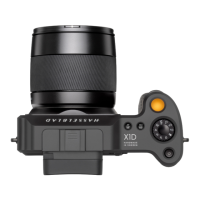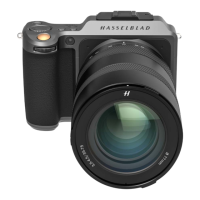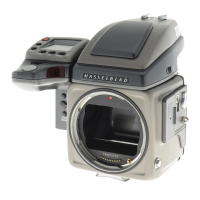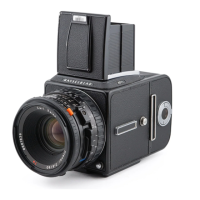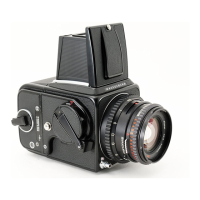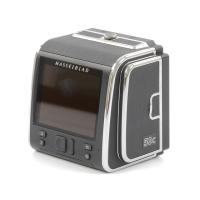
Do you have a question about the Hasselblad X2D 100C and is the answer not in the manual?
| Sensor Type | CMOS |
|---|---|
| Effective Pixels | 100MP |
| Sensor Size | 43.8 x 32.9 mm |
| ISO Sensitivity | 64-25600 |
| Continuous Shooting Speed | 3.3 fps |
| Battery Life | 420 shots (CIPA) |
| Dimensions | 148.5 x 106 x 74.5 mm |
| Shutter Speed | 60 min to 1/6000 sec |
| Image Stabilization | 5-axis |
| Image Processor | Hasselblad Natural Colour Solution |
| Viewfinder | 5.76MP OLED EVF |
| Display | 3.6" 2.36MP Touchscreen LCD |
| Storage | CFexpress Type B |
| Connectivity | USB-C, Wi-Fi |
| Battery | Rechargeable Li-ion battery |
| Weight | 895 g (with battery) |
Basic overview of the Hasselblad X2D 100C camera features and capabilities.
Details the 100MP sensor, 16-bit color, and 15-stop dynamic range for vivid detail.
Explains Hasselblad Natural Colour Solution (HNCS) for authentic, true-to-life tones.
Describes the 5-axis, 7-stop IBIS for capturing crisp handheld shots.
Details the PDAF system with 294 zones for fast and accurate focusing.
Information on the integrated 1TB SSD for high-volume, high-speed storage.
Features of the 5.76-million-dot OLED EVF, including magnification and dioptre adjustment.
Information on the 3.6-inch tilting touch display and 1.08-inch top display.
Overview of Hasselblad's Phocus software for mobile and desktop workflows.
Details the USB-C 3.1 Gen 2 port for fast data transfer and charging.
Information on compatibility with XCD, H, V, and XPan system lenses.
Compatibility with XCD system lenses, including specific models.
Using H System lenses with the XH Lens Adapter or Converter 0,8.
Using V and XPan System lenses with XV or XPan Lens Adapters.
Detailed technical specifications of the X2D 100C camera.
Step-by-step instructions for charging the camera battery.
Guide on how to attach and detach lenses to the camera body.
Instructions for mounting the lens shade in normal and reverse positions.
How to insert and remove the CFexpress Type B memory card.
Steps for attaching the camera's shoulder strap securely.
General introduction to the camera's main buttons and displays.
Explains the different displays: Touch Display, EVF, and Top Display.
Details touch gestures and controls for navigating the camera interface.
How to switch between different camera screen views using gestures.
Navigating and adjusting camera settings via the Control Screen.
How parameters are locked or automated in Aperture, Shutter, and Program modes.
Explains various settings accessible and adjustable on the Control Screen.
Detailed explanation of selecting and using Manual, Aperture, Shutter, Program, and Full Auto modes.
Explains autofocus (AF) and manual focus (MF) modes and how to select them.
How to activate autofocus and interpret focus point indicators (white, green, red).
Understanding the AF system's focus point status indicators (grey, white, green, red).
Using AF-S mode for focus lock, allowing recomposition without losing focus.
Guide to using manual focus, including MF Assist options like Auto Zoom.
How the camera automatically zooms to 100% for focus checking when rotating the focus ring.
Using the focus indicator (triangles, circles) to guide manual focus adjustments.
How to move and resize the focus point on the touch display or EVF.
Explains Single, Continuous, Self Timer, Interval, and Exposure Bracketing drive modes.
How to enable/disable in-body image stabilisation (IBIS) and its limitations.
Information on storing images on the internal 1TB SSD, including formatting.
Details on CFexpress Type B memory cards, recommended types, and formatting.
Using the EVF, touchpad operations, dioptre adjustment, and screen display settings.
How to browse, view details, rate, and delete images on the camera.
Overview of the camera's main menu structure and navigation.
Configuration options for exposure compensation, shutter function, and ISO limits.
Using electronic shutter, its limitations, and true exposure settings.
Explanation of the True Exposure function and its effect on shutter speed.
Setting and understanding shutter speed limits based on focal length or mode.
Defining maximum and minimum ISO values for Auto ISO mode.
How the display simulates final image exposure in Live View.
Settings for exposure lock, increment step size, B/T mode, and max aperture.
Options for autofocus point size, reset, AF result sound, and manual focus assist.
Adjusting image format (RAW, JPG) and bit depth (14-bit, 16-bit).
Configuring flash sync timing and exposure lock until flash is ready.
Customizing EVF/Rear Screen display, brightness, and preview options.
Managing display off timer, auto power off, and power settings when tethered.
Configuring primary/secondary storage, destination, and formatting SSD/CFexpress.
Enabling/disabling in-body image stabilisation and setting focal length.
Connecting to Wi-Fi, selecting mode, and managing paired devices.
Main category for touch, buttons, profiles, date, language, service and about settings.
Configuration for touch controls, including touchpad area and sensitivity.
Selecting touch display area and sensitivity for EVF touchpad use.
Customizing camera buttons, scroll wheels, and control rings.
Saving and loading camera settings into custom profiles.
Calibrating the camera's spirit level for accurate tilt indication.
Setting the camera's date and time.
Changing camera language and unit of distance.
Firmware updates, default settings, file counter and log data management.
Resetting camera settings to factory defaults.
Saving or deleting camera log data for technical support.
Viewing product information, licenses, and compliance details.
Introduction to Phocus Mobile 2 and Phocus software, their features and benefits.
Guide to connecting and using the Phocus Mobile 2 app on iOS devices.
Instructions for connecting the camera to a computer for tethered shooting with Phocus.
How Phocus enhances image quality using HNCS and DAC, reducing moiré.
Information on Hasselblad's RAW file formats (3FR, 3F) and their development.
Step-by-step guide to changing the camera's display language.
Troubleshooting steps for common error messages and how to contact support.
Instructions for safely cleaning the camera's IR sensor filter.
Methods for removing dust and smudges from the lens glass.
Explanation of Exposure Value (EV) and its relationship to aperture and shutter speed.
Overview of available accessories for the X2D 100C camera.
Using the XH Lens Adapter to mount HC/HCD lenses on the X2D 100C.
Details on the XH Converter 0,8 for reducing focal length and increasing aperture.
Using the XV Lens Adapter to attach Hasselblad V System lenses.
Information on the tripod mount ring for added camera stability.
Using the XPan Lens Adapter for XPan camera lenses.
Features and usage of the Hasselblad Battery Charging Hub.
Details on extension tubes for HC lenses.
Information on the adjustable bellows lens shade for light protection.
Details on bayonet mount adapters for Pro Shade V/H.
Benefits and sizes of UV Sky filters for protecting the lens and reducing haze.
Information on polarizing filters for reducing glare and increasing saturation.
Accessory for rapid attachment/removal of the camera to a tripod.



